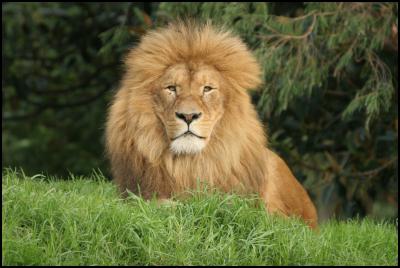200kg cat to be couriered across Tasman

MEDIA
RELEASE
12 September 2012
200kg cat to be couriered across Tasman
Auckland Zoo’s male lion Lazarus, who has fathered six offspring since his arrival in 2003, is today being air-freighted across the Tasman to start a new life at Taronga Western Plains Zoo in Dubbo, New South Wales.
The move, part of an Australasian regional breeding programme for this big cat species, paves the way for Auckland Zoo’s other male lion, Ngala, to step up and lead the pride of three females, and hopefully breed.
Lazarus, who weighs 200kg, will travel in a special custom-built steel crate on a Tasman Cargo Airlines Boeing 757 freighter aircraft that will also be carrying express parcels, boutique clothing, fresh fish and other food products. Horses – frequent flyers on this aircraft, have been rescheduled to fly on a different day this week to give this big cat priority passage.
One of Lazarus’s keepers, David Crimp, will also travel on the aircraft. From Sydney airport, it will be a six-hour road trip to Western Plains Zoo where Mr Crimp will spend the week helping settle Lazarus in.
Lazarus and Ngala, now both 10 years old, arrived at Auckland Zoo from South Africa in early 2003, with Lazarus exerting his dominance from the start. Both cats, orphaned as cubs in the Kalahari and Kruger National Park areas respectively, owe their survival to those that hand-reared them at Cango Wildlife Ranch in Oudtshoorn.
“Left to fend for themselves, they would never have survived. They are both genetically valuable, so it’s fantastic that they can contribute to the Australasian programme and play a really important advocacy role for their wild cousins,” says Auckland Zoo Pridelands team leader, Nat Sullivan.
The African lion population is continuing to decrease in the wild, with most of the population now restricted to protected areas in national parks. Lions are poached by hunters, and farmers also shoot any lions they come across for fear they will hunt their cattle.
Fast Facts
• Lions are
‘apex’ predators, meaning they are at the top of the
food chain, and help keep the ecosystem naturally
sustainable by hunting animals further down the chain
• In 1900, there were up to one million African lions.
Today the African lion is listed as ‘Vulnerable’ on the
IUCN (World Conservation Union) Red List of threatened
species, with recent surveys indicating there could be fewer
than 25,000. Visit www.iucnredlist.org/details/15951/0
Ends


 Gordon Campbell: On The Aussie Election Finale
Gordon Campbell: On The Aussie Election Finale UnionAID: Fiji Union Leader Visiting NZ Highlighting Struggle Of Garment Workers
UnionAID: Fiji Union Leader Visiting NZ Highlighting Struggle Of Garment Workers Hokotehi Moriori Trust: Historic Translocation Of Hakoakoa Marks New Chapter In Moriori Conservation Leadership
Hokotehi Moriori Trust: Historic Translocation Of Hakoakoa Marks New Chapter In Moriori Conservation Leadership Department Of Internal Affairs: Government Chief Digital Officer Issues Standard To Protect Government-Held Personal Information
Department Of Internal Affairs: Government Chief Digital Officer Issues Standard To Protect Government-Held Personal Information Te Pāti Māori: Keep The Window Open- UCOL Must Stay
Te Pāti Māori: Keep The Window Open- UCOL Must Stay Unions Otago: May Day Workers' Hui
Unions Otago: May Day Workers' Hui People Against Prisons Aotearoa: Voting Ban “Undermines Democratic Principles” Says Justice Group
People Against Prisons Aotearoa: Voting Ban “Undermines Democratic Principles” Says Justice Group


